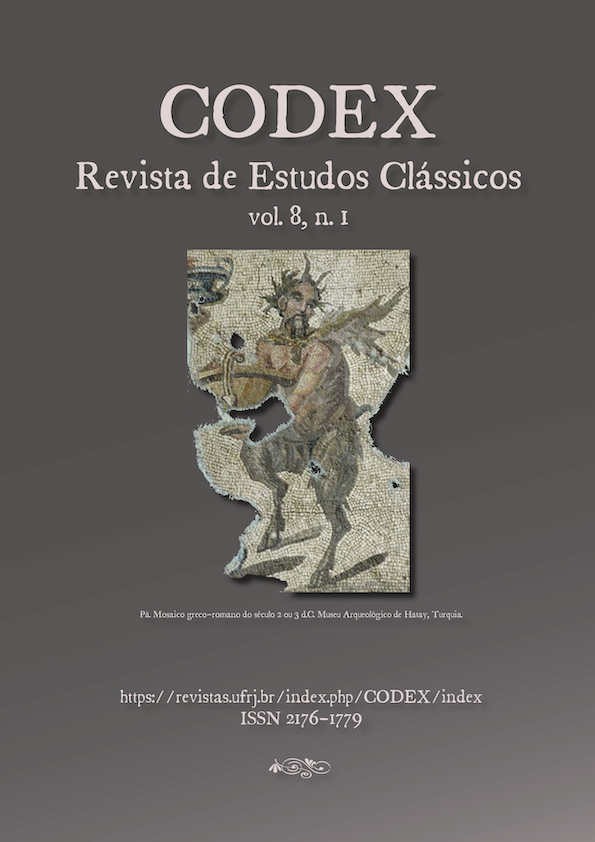The characterization of the Danaids in Aeschylus’ "Suppliants"
DOI:
https://doi.org/10.25187/codex.v8i1.32946Keywords:
Greek tragedy, Aeschylus, The Suppliants, characterization, othernessAbstract
Aeschylus’ Suppliants, represented around 463 B.C., tells the story of the fifty daughters of Danaus, who, fleeing from their homeland, Egypt, reach Argos, land of their ancestral Io, seeking asylum and protection. The young girls arrive fleeing from their cousins, the Egyptians, who intend to marry them by force. This paper aims to discuss some aspects of the characterization of the Danaids in this Aeschylean tragedy, having as a common thread the pair of Greek-Barbaric opposites and trying to observe to what extent this characterization creates what Hartog (1980) calls “otherness effect” and how this “otherness effect” is at the service of a majority pejorative representation of the barbarians.
References
Fontes primárias:
AESCHYLUS. The Suppliants. Edited by H. Friis Johansen and E. W. Whittle. 3 vol. Copenhagen: Gyldendal, 1980, vol. 1: Bibliography, Introduction, Text, Apparatus, 120 pp.; vol. 2: Commentary 1-629, 517 pp.; vol. 3: Commentary 630-1073, Indices, 480 pp.
ÉSQUILO. As Suplicantes. Prefácio, introdução, tradução e notas de Ana Paula Quintela Ferreira Sottomayor. Coimbra: Instituto de Estudos Clássicos, 1968.
ÉSQUILO. Oresteia. Estudo e tradução de Jaa Torrano. 3 vol. São Paulo: Iluminuras / FAPESP, 2004.
ÉSQUILO. Tragédias: Os Persas, Os Sete contra Tebas, As Suplicantes, Prometeu Cadeeiro. Estudo e tradução de Jaa Torrano. São Paulo: Iluminuras, 2009.
HERÓDOTO. História. Tradução do grego, introdução e notas de Mário da Gama Kury. 2a ed. Brasília: Editora Universidade de Brasília, 1988.
HOMERO. Ilíada. Tradução de Christian Werner. São Paulo: Ubu Editora / SESI-SP Editora, 2018.
TRAGICORUM GRAECORUM FRAGMENTA. Ed. Radt, S. Göttingen: Vandenhoeck & Ruprecht, 1985.
Bibliografia de apoio:
AMENDOLA, S. Xenoi and Greeks between opposition and ‘hybridization’. Some observations about the lexicon of the otherness in Aeschylus’ survived tragedies. Humanitas, 74, 2019, pp. 9-28.
CAIRUS, H. Quando o nómos não é a lei. In: Influência, Arte, Debates, Cultura, Direito, Oriente. São Paulo: Uninove, 2004, pp. 19-25.
DE PAOLI, B. A adivinhação na tragédia de Ésquilo. Tese (Doutorado em Letras Clássicas) – Departamento de Letras Clássicas e Vernácula, Universidade de São Paulo, São Paulo, 2015.
FASSIN, É. Le mot race – Cela existe (1/2). AOC (Analyse Opinion Critique), 10/04/2019.
FASSIN, É. Le mot race – Cela existe (2/2). AOC (Analyse Opinion Critique), 11/04/2019.
FERNÁNDEZ DEAGUSTINI, M. del P. La condición de ser “Otro” en Suplicantes de Esquilo: un análisis (comparativo) de la escena del Heraldo de los Egipcios. Phoînix, vol. 24, n. 1, pp. 43-65, 2018.
GANTZ, T. N. Love and Death in the Suppliants of Aischylos. Phoenix, 32, n. 4, 1978, pp. 279-287.
GARVIE, A. F. Aeschylus’ Supplices: Play and Trilogy. Cambridge: Cambridge University Press, 1969.
HALL, E. Inventing the Barbarian: Greek Self-Definition through Tragedy. Oxford: Oxford University Press, 1989.
HARTOG, F. O espelho de Heródoto: Ensaio sobre a representação do outro. Trad. Jacyntho Lins Brandão. 2a ed. Belo Horizonte: Editora UFMG, 2014 [1980].
JANNIDIS, F. Character. In: HÜHN P; MEISTER, J. C; PIER, John; SCHMID, W. (eds). The Living Handbook of Narratology. Hamburg: Hamburg University Press, 2012. Disponível em: . Acesso em: 15 de janeiro de 2020.
MITCHELL, L. G. Greeks, barbarians and Aeschylus’ Suppliants. Greece & Rome, 53, n. 2, 2006, pp. 205-223.
Pour Eschyle. Disponível em: <https://www.theatre-du-soleil.fr/fr/guetteurs-tocsin/pour-eschyle-103> Acesso em: 10 de agosto de 2019.
RIBEIRO, T. O. A apódexis herodotiana: um modo de dizer o passado. Tese de Doutorado (Letras Clássicas) – Departamento de Letras Clássicas, Universidade Federal do Rio de Janeiro, Rio de Janeiro, 2010.
SOMMERSTEIN, A. H. Notes on Aeschylus’ Suppliants. Bulletin of the Institute of Classical Studies, 24, n. 1, 1977, pp. 67-82.
VIDAL-NAQUET, P. The Place and Status of Foreigners in Athenian Tragedy. In: PELLING, C. (ed.) Greek Tragedy and the Historian. Oxford: Oxford University Press, 1997, pp. 109-120.
WINNINGTON-INGRAM, R. P. The Danaid Trilogy of Aeschylus. The Journal of Hellenic studies, 81, 1961, pp. 141-152.
Downloads
Published
How to Cite
Issue
Section
License
This work is licensed under a Creative Commons Attribution-NonCommercial 4.0 International License.










